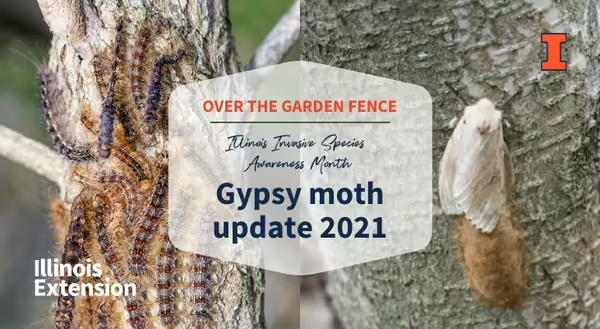
For more than 20 years, the Illinois Department of Agriculture (IDOA) has been continually monitoring gypsy moth in an effort to track infestations, put quarantines in place, and provide treatments.
Gypsy moth caterpillars are voracious eaters and can cause major defoliation. They will feed on more than 500 different kinds of trees and shrubs. Some may recall Lake County’s quarantine in 2000. McHenry, Cook, and DuPage counties were identified in 2007, and a decade later, Will, Kane, Kendall, and LaSalle were added.
A feel-good story in the gypsy moth saga is there are no treatments planned in Illinois in 2021. This really demonstrates the effectiveness of previous surveys and treatments. It is critical to make the treatments at just the right times to control a higher percentage of gypsy moth (successful in 2020 even with the pandemic). One such elimination of gypsy moth occurred at the Morton Arboretum in Lisle, Ill.
The second half of that story is homeowners and the general public spent more time outdoors – gardening, walking, jogging, and doing outdoor socially-distanced activities – and as a result, there has been more observation and awareness of pest issues, including gypsy moth. Reports to IDOA have increased, and sightings have included all stages – egg masses, caterpillar feeding, and adults (usually the females, as they are easy to identify given their bright coloring).
Couple the increased reporting with the more than 11,000 gypsy moth survey traps in 2020, and you can see the whole picture. Trapping happens throughout Illinois between IDOA and the Federal Animal Health Plant Inspection Service’s (APHIS) Plant Protection and Quarantine (PPQ) program. Efforts target both previously infested areas and the remainder of Illinois. This data allows for better interpretation and analysis of populations, which in turn allows IDOA to focus on critical areas for future treatments.
What can you do to help?
- Do not move firewood. The IDOA reminds us that this practice can spread gypsy moth or other invasive pests.
- Be aware of egg masses, which can be found on just about anything outside between September and April. They have been found on outdoor furniture, swing sets, children’s outdoor toys, boats, canoes, trailers, campers, and jet skis, and gardening equipment. All it takes is for something to sit in the same place a few days during egg laying. Also check travel items before moving between locations. Each fuzzy, brown egg mass can contain 500 to 1,000 eggs, so every mass that is managed lessens the potential problem for the coming year.
- Take action if you find egg masses. They should be scraped into a plastic bag, sealed, and thrown away.
- Report what you see. If you believe you have spotted egg masses, feeding caterpillars, or adult moths, you can contact IDOA at 1-866-296-MOTH (6684) or visit the IDOA website.
IDOA works to manage a variety of invasive species besides gypsy moth. Insects include Emerald Ash Borer, Asian Longhorned Beetle, Spotted Wing Drosophila, Marmorated Stinkbug, and most recently the Spotted Lanternfly. Plant disease is yet another area monitored; Boxwood Blight and Thousand Cankers Disease of walnut are just two examples. In addition, other agencies do similar work with invasive species, such as Illinois Department of Natural Resources with Asian carp and Zebra mussels.
Learn more about Illinois invasive species.
Want to know when new topics post here? Subscribe to Over the Garden Fence emails.
About the author: Richard Hentschel’s expertise extends across several subject areas with specialties in lawn care, fruit tree production, woody ornamentals, and home and community gardening. During his 45-year career in horticulture and agriculture, Hentschel became a well-known and respected expert for commercial and homeowner audiences, industry organizations, and media. He retired from University of Illinois Extension in April 2022 with nearly 30 years of service as a Horticulture Specialist and Educator in northern Illinois.